Mauna Loa’s long-awaited eruption this morning was a surprise but, in some ways, not. It has been pending for months. Can you imagine living on the street in our featured photo and looking up at the eruption? People are being warned of potential VOG, while some Kona residents are already self-evacuating.
Now that the eruption has begun, there are initially more questions than answers as to what the impact will be on Big Island residents first and foremost. That’s where our thoughts are focused. Currently, the lava is slow-moving, at least, giving people more time to prepare for any possible evacuation.
As you’ll see below, there will be many other considerations, some good, and some not-so-good, with implications for Hawaii travel.
USGS 5 pm update.
“The eruption of Mauna Loa continues on the Northeast Rift Zone. Three fissures erupted and as of 1:30 PM, only the lowest of the three fissures was active. Estimates of the tallest fountain heights are between 100–200 ft (30 – 60 m), but most are a few yards (meters) tall. The fissures sent lava flows to the northeast and parallel to the rift zone. Lava flows from the two higher fissures moved downslope but stalled about 11 miles (18 km) from Saddle Road. Fissure 3 is currently feeding lava flows moving east parallel to the Northeast Rift Zone. These remain at above 10,000 feet elevation and over 10 miles (16 km) away from Saddle Road. We do not expect upper fissures to reactivate. However, additional fissures could open along the Northeast Rift Zone below the current location, and lava flows can continue to travel downslope. There is no active lava within Moku’āweoweo caldera, and there is no lava erupting from the Southwest Rift Zone. We do not expect any eruptive activity outside the Northeast Rift Zone. No property is at risk currently. There is a visible gas plume from the erupting fissure fountains and lava flows, with the plume primarily being blown to the Northwest.”
Impact on flights to and from Hawaii.
So far today, we do not see any reason for disruption in flights to or from Hawaii. That could, of course, change since this is so fast evolving. The ash advisory has been discontinued for now. Update: Southwest has canceled all Hilo flights for Monday, November 28. Hawaiian Airlines is operating normally.
The plumes of volcanic ash already occurring near Mauna Loa present a potential flight safety hazard, which is exacerbated for night flights. The reason is that the ash is hard and highly abrasive. It can damage or wear jet compressor blades and has the potential to damage cockpit windows too. Ash could also contaminate the fuel system and cause other aircraft problems. It can even cause engine failure in the worst case.
For over 20 years, the aviation industry has set up Volcanic Ash Advisory Centers to act in a liaison role between the industry and meteorologists. Then in 2010, the engine manufacturers began to define safety levels for volcanic particles when a volcano caused widespread disruption to the industry. The UK CAA, for example, set the limit at 4mg per cubic meter of air space.
It’s interesting to note that the ash near the eruption plume differs from that downwind. The most dangerous is closest to the eruption plume, and the download risk is substantially lower.
State of Hawaii and HVCB had this wrong.
You may recall that just a month ago, the state warned the media, including BOH, via its marketing arm HVCB: “To back off on its hyped reporting about the Mauna Loa volcano on the Big Island.” HVCB said, “Maunaloa is not erupting, and there are no signs of an imminent eruption. Recent news of the U.S. Geological Survey (USGS) Hawaiian Volcano Observatory (HVO) monitoring Maunaloa volcano on the island of Hawaii should cause no reason for travelers to alter their travel plans to Hawaii Island at this time. HVO continues to monitor any changes at Maunaloa, issuing daily updates until further notice.” Mauna Loa volcano on the Big Island last erupted in 1984. There is no reason at this time for travelers to change or alter their leisure or business plans.” Clearly, the talk of a possible eruption was bad for business.
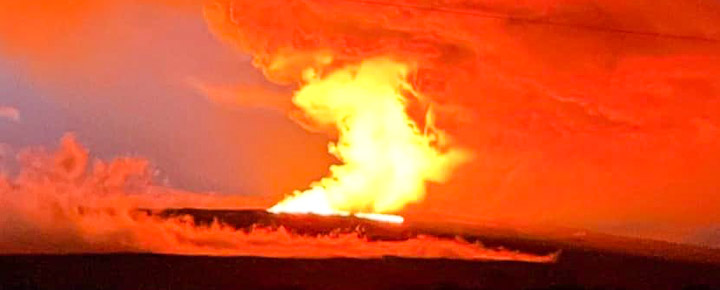

History of Mauna Loa Eruptions.
The current eruption zone, Mauna Loa’s Northeast Rift Zone, previously erupted 8 times since the mid-1800s. Those occurred in 1843, 1852, 1855–1856, 1880–1881, 1899, 1935–1936, 1942, and 1984. The lava flow from that zone can travel in many directions on the Big Island, including north, west, northwest, south, and southwest.
“Lava flows can change rapidly.” – USGS said regarding today’s eruption.
The eruption of Mauna Loa began at the summit and overnight migrated to the “Northeast Rift Zone,” where lava flow has been seen flowing. In a flyover this morning, it was determined that, at this time, lava flows are not threatening any Big Island communities, with the initial indication being that it will remain in the current rift zone.
It is typical for lava flows to erupt from either the volcano summit or at rift zones along its flanks. Lava travels downhill toward the ocean, and it buries everything en route. As lava enters the Pacific, it can build new land called deltas. The deltas are capable of long-distance (hundreds of yards) explosive activity associated with sudden collapse.
USGS said this morning, “based on past events, the early stages of a Mauna Loa rift zone eruption can be very dynamic, and the location and advance of lava flows can change rapidly.”
Last year’s eruption at Kilauea provoked this response re VOG from USGS.
When Kilauea erupted in the fall of 2021, USGS said that “high levels of volcanic gas are the primary hazard of concern, as this hazard can have far-reaching effects downwind. Large amounts of volcanic gas—primarily water vapor (H2O), carbon dioxide (CO2), and sulfur dioxide (SO2)—are continuously released during the eruptions.”
When SO2 is released from a volcano, it reacts in the atmosphere and creates VOG (volcanic smog). USGS said, “Vog creates the potential for airborne health hazards to residents and visitors, damages agricultural crops and other plants, and affects livestock.”
Vog has been an ongoing airborne hazard in Hawaii for both residents and visitors. The worst situation we can recall began in 2007. It was extremely irritating, blanketed the Big Island, and was even a noxious problem 250 miles away on Kauai.
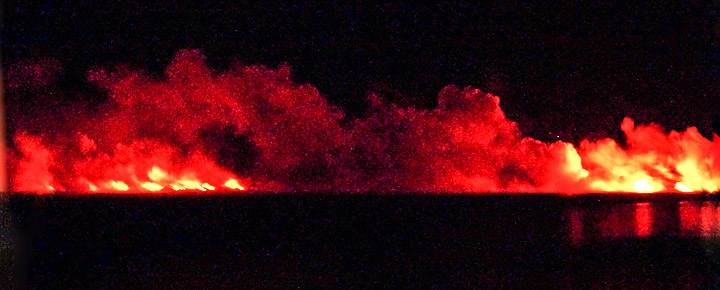

Volcano Travel to Big Island will resume.
Case in point: last year’s volcanic eruption in the Canary Islands left devastation, with homes and businesses disappearing in minutes. On the island of La Palma, the 85-day eruption destroyed 3,000 buildings.
Now, however, volcano tourism has become the silver lining that caused travel to rebound on La Palma with a vengeance, and visitors are arriving from both near and far. Volcanos are fascinating, pure, and simple. BOH editors traveled to the Big Island to see this lava flow from the water at night in 2016, as we photographed above.
Volcano help pages.
1. USGS volcano updates. https://www.usgs.gov/volcanoes/mauna-loa/volcano-updates.
2. Big Island emergency response resources. https://www.hawaiicounty.gov/
3. Information on Hawaii Volcanoes National Park, including closures. https://www.nps.gov/havo/index.htm.
4. Vog information site. https://vog.ivhhn.org/.
Get Breaking Hawaii Travel News

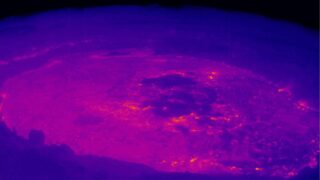

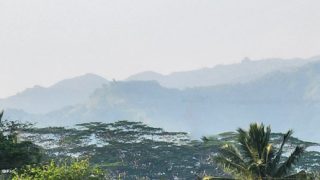
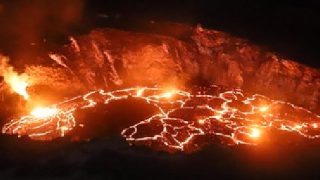
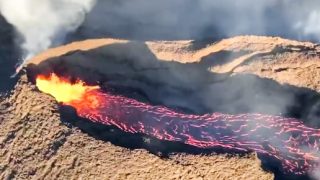
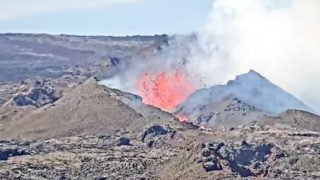
We have been on the Big Island when the volcano is running. That VOG stuff is very unpleasant. I know that some people come to the Big Island just to see the erupting volcano. We would not come to the Big Island during an eruption because of the VOG.
Aloha
Wait a minute… didn’t you guys say that the media hyped up the news a month ago and that the volcano was not going to erupt any time soon?
Both HA and SWA made good decisions. HA is the expert on Hawaii, the pilots have a lot of experience inter island and the dispatchers are in HNL and know the weather patterns well. SWA dispatchers are on the mainland, relatively clueless about Hawaii and many of the pilots are inter island part timers who occasionally fly an inter island leg. It would have been irresponsible for them to operate without really knowing the situation. Good call for both.
I believe the article stated that HA is operating normally.
Of course, that was my point. HA is based in Hawaii and knew they could safely operate. Inter island for SWA is dispatched from the mainland by people that have no local knowledge of the actual conditions. SWA flight crew also has far less experience with Hawaii’s unique environment.
While your editorial was balanced enough, there is reportage (the Washington Post has an excellent summary) that modifies some of your observations. These include:
1. Once Mauna Loa defines a rift zone for flow outside the caldera, it usually does not change direction. The direction for this eruption is NE, good news for both east and west sides. The down slope on the NE zone is very gradual and could take weeks or months before reaching populated areas.
2. Pele’s hair is a significant risk only for those living near the volcano (almost no one) though finer thread can be carried by the wind (predominantly trades).
3. Even the vog situation is quite different than Kilauea vog since Kilauea is on the south and east side.
Stay calm.
Make your travels take at your own risks laws or pay for your own rescue if need be.
People come for fun but they also involved risky rescues on the Mountains and the oceans.
Mauna Kea 2021 eruption ???
Good Luck and thoughts to everyone that this eruption affects!
Foremost I hope there won’t be damage or loss to the BI residents and businesses. We are scheduled to arrive this weekend and monitoring closely.
We have a booked trip to the Big Island for February. Is there any reason to be concerned about that?
No.
Of course there is. At a minimum you should purchase some travel insurance.
Empathy for your concern but February is ages away and lots …or very little beyond what’s already happening…can change from full blown lava rivers descending to populated areas to staying the same to a complete stop although that seems unlikely.
If you’re visiting in the north and west… the Hamakua coast there’s little to fear…but the rest of the island could see an increase in ash fall …and fumes…not healthy.
I have lived on the BI through three Kilauea eruptions and now Mauna Loa. This one is quite different. Eruptions are typically localized events, affecting small portions of a very big island. This one is quite different. Several NE fissures are sending any lava towards Hilo along a very gradual slope. Could take weeks or months a continued eruption to reach populated areas. Even the vog (volcanic smog) and wind predictions send most vog northwest towards Maui, Oahu and Kauai.
Unless you are super sensitive to respiratory issues, there is no reason not to visit the island on this historic event.